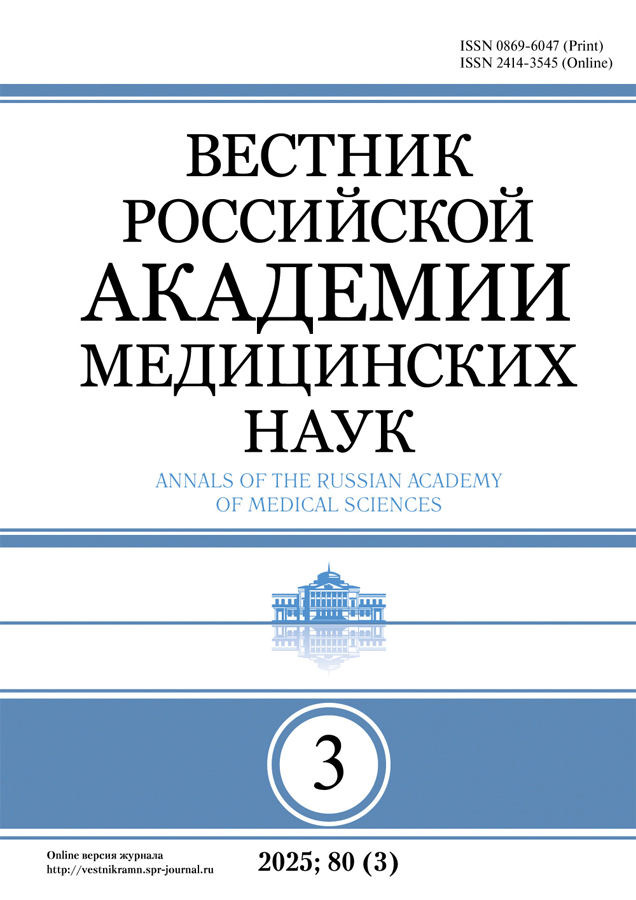NEW THERAPY SCHEMES FOR ACUTE, SUBACUTE AND CHRONIC VARIANTS OF EXTRINSIC ALLERGIC ALVEOLITIS
- Authors: Makar'yants N.N.1, Shmelev E.I.1
-
Affiliations:
- Central TB Research Insitute of RAMS
- Issue: Vol 67, No 11 (2012)
- Pages: 39-44
- Section: PHTHISIOLOGY: CURRENT ISSUES
- Published: 10.11.2012
- URL: https://vestnikramn.spr-journal.ru/jour/article/view/245
- DOI: https://doi.org/10.15690/vramn.v67i11.470
- ID: 245
Cite item
Full Text
Abstract
In order to improve treatment of patients with exogenous allergic alveolitis morphologically different variants of the disease, i.e. acute, subacute and chronic were identified and confirmed. For each variant of exogenous allergic alveolitis new therapy schemes were proposed. The study included 74 patients who were divided into 5 groups. In the first group with acute exogenous allergic alveolitis inhalation glycocorticosteroids in high doses in combination with plasmapheresis were prescribed, in the second group standard therapy with systemic glycocorticosteroids was prescribed. The third and the fourth group consisted of patients with subacute exogenous allergic alveolitis. The protracted ambroxol inhalation using nebulizers and the reduced dose of systemic glycocorticosteroids were used in the third group; and the standard dose of systemic glycocorticosteroids was used in the fourth. The fifth group consisted of patients with chronic exogenous allergic alveolitis, who received the standard dose of glycocorticosteroids and cytostatic drugs. After one month of therapy, it was ascertained that the use of high doses of inhalation glycocorticosteroids in combination with plasmapheresis in patients with acute exogenous allergic alveolitis led to significant improvements in clinical and CT presentation, physical activity tolerance, as well as the use of systemic glycocorticosteroids. The use of ambroxol inhalation in patients with subacute exogenous allergic alveolitis led to a significant improvement in clinical symptomatology, functional parameters and CT presentation, thus enabling to reduce the dose of glycocorticosteroids used and to avoid unwanted side effects.
About the authors
N. N. Makar'yants
Central TB Research Insitute of RAMS
Author for correspondence.
Email: roman4000@yandex.ru
Russian Federation
E. I. Shmelev
Central TB Research Insitute of RAMS
Email: roman4000@yandex.ru
Russian Federation
References
- Disseminirovannye protsessy v legkikh. Pod red. N.V. Putova [Disseminated Pulmonary Processes. Edited by N.V. Putov]. Moscow, Meditsina, 1984. 221 p.
- Vasil'eva O.S., Velichkovskii B.T., Spirin V.F. Respiratory diseases of organic dust in agricultural production. Pul'monologiya = Pulmonology. 1996; 4: 5–9.
- Differentsial'naya diagnostika disseminirovannogo tuberkuleza legkikh i ekzogennykh allergicheskikh al'veolitov razlichnoi prirody (po dannym morfologicheskogo issledovaniya). Ocherednoi 9-i s"ezd ftiziatrov Rossii [Differential diagnosis of disseminated pulmonary tuberculosis and exogenous allergic alveolitis different nature (according to morphological studies). Once the 9th Congress of Russian TB doctors]. Moscow, 2011.
- Antipova A.V. Diagnostika ekzogennykh al'veolitov razlichnoi prirody (kliniko-instrumental'noe issledovanie). Avtoref. diss. … kand. med. nauk [Diagnosis of exogenous alveolitis different nature (clinical and instrumental examination). Author’s abstarct]. Moscow, 2010.
- Karpina N.L. et al. Vliyanie aktivatorov surfaktantnoi sistemy legkikh na techenie posleoperatsionnogo perioda u bol'nykh destruktivnym tuberkulezom legkikh. Mat-ly nauchn. sessii TsNIIT RAMN «Aktual'nye problemy tuberkuleza i boleznei legkikh» [Effect of activators lung surfactant system in the postoperative period in patients with destructive pulmonary tuberculosis. Materials of Scien. Session CTRI RAMS "Actual problems of Tuberculosis and Lung Disease"]. Moscow, 2006. p. 91–92.
- Lovacheva O.V. et al The results of the drug surfactant in the complex therapy bolyh destructive pulmonary tuberculosis. Probl. tub. i bol. legkikh = Problems of tuberculosis and lung diseases. 2006; 10: 12–17.
- Erokhin V.V., Lepekha L.N. Surfaktant i infektsiya [Surfactant and infection]. Moscow, TsNIIT RAMN, 2004. p. 80–86.
- Prokop M., Prokop Sh., Galanski M. Spiral'naya i mnogosloinaya komp'yuternaya tomografiya [Golan and multilayer spiral computed tomography]. Moscow, MED-press inform, 2009. p. 144–145.
- Disseminirovannye protsessy v legkikh. Pod red. N.V. Putova [Disseminated Pulmonary Processes. Edited by N.V. Putov]. Moscow, Meditsina, 1984. p. 221.
- Putov N.V., Il'kovich M.M. Ekzogennyi allergicheskii al'veolit. Fibroziruyushchie al'veolity [Extrinsic allergic alveolitis. Fibrosing alveolitis]. Leningrad, 1986. p. 100–134.
- Eglite M.E. Allergicheskie zabolevaniya u ptitsevodov [Allergic disease in poultry farmers]. Riga, Zinatne, 1990. p. 86–108.
- Vasil'eva O.S. Extrinsic allergic alveolitis in agriculture. Report at the 5th Nat. Congress on the RS. Respiratory organs. Pul'monologiya = Pulmonology. 1995; 1: 719.
- Lepekha L.N. Sistema surfaktanta v norme i pri patologii organov dykhaniya. Respiratornaya meditsina. Ruk-vo pod red. A.G. Chuchalina [System surfactant in health and disease of the respiratory system. In: "Respiratory Medicine". Edited by A.G. Chuchalin]. Moscow, «GEOTAR-Media», 2007. p. 156–165.
- Van Iwaarden J.F., Classen E., Jeurissen S.H. Alveolar masrofages, surfactant lipids, and surfactant protein B regulate the induction of immune responses via the airways. Am. J. Respir. Cell Moll. Biol. 2001; 24 (4): 452–458.
- Wright J.R. Immunomodulatory function of surfactant. Physiol. Rev. 1997; 77: 931–942.
Supplementary files








